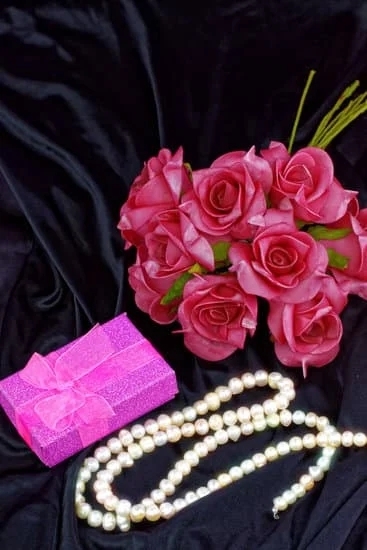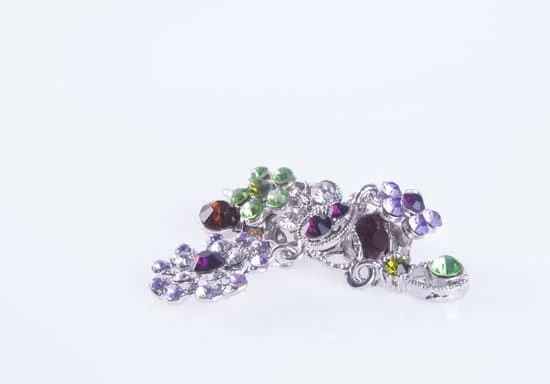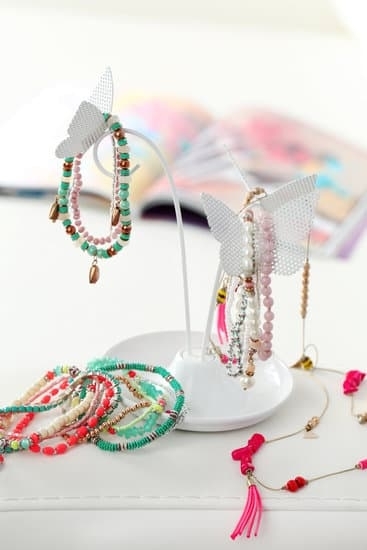The Victorian Era was a time of immense change, innovation and development within the arts, fashion and jewelry-making industry. During the 19th century, developments in technology, tools and fashion inspired a renewed interest in luxurious jewelry with intricate detailing. Though the exact origins of Victorian Era jewelry are unknown, historians continue to explore the history behind it.
One of the most recognizable aspects of Victorian Era jewelry is its clear differentiation between European and Eastern styles. Craftsmen often combined elements of both Eastern and European design, incorporating traditional designs such as filigree or engraving but adding an unexpected twist.
In addition to more refined craftsmanship techniques being used during this time period, there was also an abundance of raw materials to work with including gemstones, seashells and metals like gold or silver. This combination of design elements from both East and West resulted in beautiful pieces embellished with jewels that pushed boundaries while also honoring traditional methods such as hand-hammering components or engraving intricate motifs onto gold or silver plating.
The popularity of Victorian Era jewelry influenced trends well into the 20th century before fading out around World War I. Since then, contemporary artisans have begun to reinterpret Victorian pieces with updated styles that still honor their unique influence on jewelry culture.
Many modern jewelers explore bold colors and textures inspired by these timeless designs but give them a modern edge. The resurgence of vintage-inspired jewelry has brought back countless iconic items from this era such as chokers featuring diamonds set within ornate bands crafted from precious metals like platinum or yellow gold.
Overall, although much remains unknown about the exact origins of Victorian Era Jewelry’s distinct style others have put significant effort into researching its influence on today’s society. Many shapes can still be seen worn proudly by many people today – representing how varied our tastes were centuries ago still maintain relevance today thanks to its prominence in popular culture throughout the ages.
With contemporary reinventions coming forth every day – it’s not hard to find someone wearing one piece or another inspired by this decadent era or pastime.
The Craftsmanship and Artistry of Victorian Jewelry
The Victorian era of jewelry was a time of unprecedented beauty and craftsmanship that has yet to be replicated by any other era. The era spanned from 1837-1901, and during those years some of the most spectacular jewels were created. Many passionate artisans during this period were highly skilled in their craft and would create pieces that would be showcased around the world for decades to come.
It was made with many different materials such as gold, silver, and precious stones like diamonds and pearls. The pieces also used intricate metalwork, engravings and enamel designs that no other period could match.
The Edwardian period saw an uptick in experimental elements being added to pieces of jewelry to further reflect on nature and its delicate beauty, such as butterflies or birds carved out of delicate gold or platinum, along with stunning emeralds, rubies or sapphires. At the same time, circular shaped jewellery became popular within this period because they represented eternity so well.
Often set with pearls or gemstones these shapes truly reflected on a timeless design aesthetic from an era gone by.
Jewellery during the Victorian Era boasted ornate detailing, filigree worked structure as well as naturalistic motifs such as leaves and petals delicately entwined into bracelet links or locket frames; antique Hearts lockets are a great example of this kind of craftsmanship. Possessing a piece from this time is not only an asset but also holds a certain charm that speaks volumes about its history.
Nothing can quite compare to the beauty crafted during the era by hand in almost every single piece that survived until today’s date.
Influential People Who Wore Victorian Jewelry
The Victorian Era was a period during the reign of Queen Victoria in 19th century England that spanned 1837-1901. It encompassed a variety of cultural innovations and dramatic changes, but when it comes to jewelry, its impact is still seen today.
During this era, upper-class women embraced ornate jewelry of all kinds. From lavish diamond necklaces and earrings, to intricate hairstyles adorned with pearl-studded pins and feathers – decoration was abundant and spanned many different levels of expense; there was something for everyone.
Across Europe, the wealthy classes wore the most expensive gold and gemstone jewels while the middle class settled on precious metals such as silver or rose gold. The fashion of this era knew no bounds when it came to intricate detail combined with high quality materials to create statement pieces that are still admired today.
One of the most iconic pieces of this time was a brooch called the ‘forget me not’ which has recently been gaining popularity due to pop culture references in movies, books, magazines and more.
Needless to say, influential figures from the Victorian Era embraced ornamental pieces more than any other before them. Queen Victoria famously wore Coptic Revival jewels known for their embellishments which referenced religious symbols from ancient Egypt often crafted using chalcedony rocks, turquoise and coral accents paired with delicate fine metals including diamonds or pearls. Famous designer Alexander McQueen was also an avid wearer of such jewellery incorporating turquoises into his skull rings.
Royal brides including Princess Diana have also taken cues from Victorian trends adding a bohemian twist by choosing handmade headpieces for her wedding occasion pairing them with vintage lace gowns for a timeless look creating new trends in the process.
Other notable figures who have embraced modern day interpretations on statement pieces from this era include Emma Watson and Rihanna who often wear opulent brooches that are reminiscent of those seen during 1800s England – guaranteeing heads will turn whenever they are out in public.
Precious Metals and Gemstones Used in Victorian Jewelry
The Victorian era was a period of human history that is known for its romanticism and passion. It was a time when ornate jewelry was highly sought after and widely used to adorn fashionable individuals. Jewelry from the Victorian Era is recognized for the materials used, such as silver, gold, diamonds, pearls, citrine, coral and more.
In the late nineteenth century where the Victorian era became popularized in Europe, precious metals such as gold were widely used to craft ornately designed jewelry pieces. Gold necklaces were usually 15 to 18 carat jewelry grade and were decorated with turquoise gemstones to symbolize good luck or happiness.
Gold brooches often featured intricate designs of nature scenes with gems adding extra sparkle. In addition to gold, silver also became popular in this era due to its affordability while still offering a regal appearance in rings and brooches.
Another noteworthy material used during this period of history was diamonds which added an extravagant flair mostly associated with nobility alone. As diamond production increased due to industrialization it became possible for diamond accessory pieces to become available to the public at prices they could afford.
Diamonds replaced turquoises at times as decorations within jewelry as they became available on the open market in places such as India and Africa. Pearls were immensely popular among aristocrats during this time period because they could be worn around the neck or join other stones within earrings or pins making them versatile accessories that complemented any style of clothing from ball gowns t0 day wear outfits.
The most common types of pearls included Cultured Japanese Akoya Pearls, Freshwater Pearls and South Sea Pearls depending on budget investment level wanted by the purchaser beads providing an affordable option for those shopping for more casual everyday pieces. Citrine quartz, peridot and rose quartz added delicious splashes of color often seen in earrings alongside freshwater pearls amongst other antique stones depicted through glass beadwork admired by many but beloved by all.
Lastly Coral filled Victorian showcases with delicate curved pendants formed like flowers or other supernatural figures adding timeless glamour.
Unique Varieties of Victorian Bracelets, Necklaces, and Rings
The Victorian era is one of the most well-known ages in jewelry history, featuring classic pieces and unique designs from the 19th century. Jewelry pieces from this time period were incredibly diverse, and wearers had access to a variety of distinct styles and materials.
Bracelets from the Victorian period ranged from thick, intricate gold links to intricately decorated gemstone bangles crafted of silver. Gemstones such as sapphires, rubies, diamonds, and topaz could all be found surrounding the metal framework of these bracelets and adding extra splendor to their design.
Necklaces also varied widely between large medallion pendants or tassel-trimmed chains with an array of color stone options. Locket necklaces designed to hold a family’s heirlooms or keepsakes were also highly sought-after – with petite images hidden within round cases carved with ornamental designs.
The many rings that were crafted during the years of Queen Victoria’s reign featured unique blendings of gold and gemstones. Solitaire rings featuring large central stones flanked by intricate engravings or inlaid detailing are iconic examples of this period’s artistry.
While some favor bolder statement pieces others favored more modest choices such as slender bands set with demure pavé gemstones running along only half the shank; perfect for creating timeless yet stylish looks.
Finally, Complex cluster rings were definitely in fashion during those times – they featured an interconnected combination of goldwork loops layered together around a central stone, often surrounded by smaller gemstones paving which made them look dazzling no matter how casual or formal you might be dressed for any occasion.
The 19th century was without question a golden age for ornate jewelry pieces as proven by Victorian era jewelry designs still admired today. With its array of varying styles worn by everyone from royalty to everyday folk alike it’s no surprise why so much beauty was produced during that era – each item lovingly created using both skilled techniques and unparalleled creativity.
The Influence of Victorian Jewelry on Contemporary Design
The Victorian era saw the creation of some of the most beautiful and imaginative jewelry designs ever seen. The period is characterized by a fashion for intricate and elaborate jewelry that was designed to be either displayed or worn proudly. This style was often inspired by nature, with motifs such as leaves, flowers, hearts and birds making regular appearances. As a result, much of the jewelry in this era was crafted using precious stones such as rubies, sapphires and diamonds.
In addition to these natural motifs, this period marked a dramatic shift in aesthetics with the evolution of iconic pieces such as tiaras and chokers symbolizing status, love or mourning in their beautifully ornate forms. These statement pieces have had an enduring influence on modern jewelry design. Tiaras are now commonly seen crowning brides on their wedding day while the diamond choker has been utilized by stars such as Lady Gaga and Beyonce to create unforgettable red carpet looks.
The appeal of Victorian inspired jewelry is rooted in its strong association with timeless elegance while remaining current since it stands out against modern trends. Vintage pieces from this era are sought-after collectibles due to their rarity and superb craftsmanship.
Classic designs can also be fashioned more affordably with modern materials allowing for more freedom with brighter colors such as rosy hues for a romantic look or black for glamour and drama throughout day-to-day wear thus maintaining its prominence in contemporary culture today.
Moreover, it’s undeniable that Victorian Jewelry has revolutionized contemporary design particularly Editorials thanks to many top brands embracing yesterday’s aesthetic when styling shoots creating looks which feel both classic yet contemporary at once.
For example casting directors take advantage to drop subtle nods towards yesteryear via statement earrings chains bracelets and necklaces which end up transforming mundane fashion moments into opulent statements embodying our fascination we all share for unapologetically decadent extravagant jewellery derived from distant past like victorian age so
in conclusion victorian inspired designs remain extraordinarily popular within contemporary culture which is reflected prominently on runways editorials / catwalks & our very own wardrobes due to their perfect combination of complexity glamour & beauty.
How to Clean and Preserve Victorian Jewelry Pieces
The Victorian era was a period of dramatic change in many parts of the world. It marked a time of progress and tremendous growth for England as well as other overseas countries. For many people, this was also a time of great style and fashion trends that still stand today. During the Victorian era, jewelry became increasingly popular, both for its luxurious designs and symbolic meaning. Jewelry made during the Victorian era is often finely crafted and timelessly stylish.
Victorian jewelry has seen a resurgence in popularity in recent years due to its classic beauty and intricate craftsmanship. While these pieces make a stunning addition to any wardrobe, they require special care to keep them looking their best.
As with any antique or vintage items, proper cleaning and maintenance are essential to preserving the condition of your pieces over time. Jewellery restoration specialists can help in this process by using techniques that are specifically designed for antique jewellery pieces like those from the Victorian era.
When it comes to cleaning Victorian jewelry pieces, some methods may be more effective than others depending on the type of material used for the piece. Soft gemstones like pearls should not be exposed to any harsh chemicals or direct heat. Instead, gentle soap diluted in warm water is recommended along with soft bristles from an unused toothbrush for scrubbing away dirt and grime from delicate areas.
In contrast, solid metals such as gold can be cleaned with polish specially formulated for antique jewellery pieces or even toothpaste as long as it is rinsed off afterwards with plenty of fresh water to prevent corrosion or discolouration over time. After cleaning your piece with specialized methods appropriate for each individual material type, you will want to store your jewellery properly using air tight containers or padded cases designed specifically for this purpose.
Conclusion
The Victorian era of jewelry history is known for its beauty and splendor, characterized by intricate detail, outrageously bright gemstones, and sentimental value. But beyond its opulence and grandeur, what stands out about this period of jewelry making is its lasting legacy in the world of fashion and ornamentation.
From the intricate details labeled “blackwork” that indicated mourning to brightly patterned lockets made with precious metals like gold ,silver and platinum – Victorians knew no bounds when it came to expressing their style with jewelry. Snowflake designs were popular among nobility during the winter season, whereas small remembrances called “mourning rings” were widely used by those recently deceased.
These items weren’t just for adornment but also functioned as a way of honoring loved ones who had passed away as well as love interests for those longing for companionship.
Many of the styles made during this time remain iconic today, especially the choker necklace which features large gems or medallion pendants stitched onto an ornately decorated ribbon or chain. Such pieces are particularly favored among brides in some cultures who wish to make a special statement on their wedding day.
The same can be said of brooches adorned with distinct padlocks – often shaped like roses or hearts – that first appeared during Victorian times historically as a token indicating romantic intent but have since become sought after collector’s items beloved in many countries around the world.
Finally, due to necessity born out of unprecedented industrialization that saw many artisans out of work and trade routes changing drastically – even do-it-yourself jewelry kits were created during this time that included everything needed from tools to stones to adorn locksets necklaces with one’s own personal touch. All these elements demonstrate how deeply etched this era is into jewelry making history: as both a source of nostalgic expression and a remarkable testament of creativity in tumultuous times.

Welcome to my jewelry blog! My name is Sarah and I am the owner of this blog.
I love making jewelry and sharing my creations with others.
So whether you’re someone who loves wearing jewelry yourself or simply enjoys learning about it, be sure to check out my blog for insightful posts on everything related to this exciting topic!





